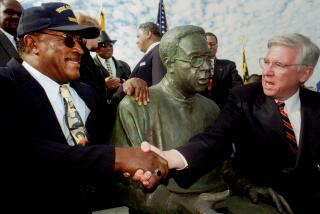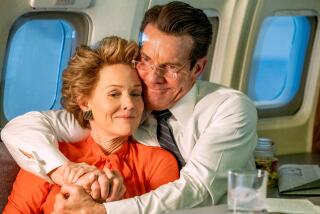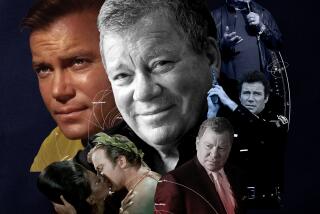FDR knew how to act the role of president
Countless actors have brought President Franklin Delano Roosevelt to memorable life in film, television and theater, including Ralph Bellamy, Edward Herrmann and Bill Murray, who plays a rather randy FDR in the new movie âHyde Park on the Hudson.â
But the person who probably portrayed the charismatic Roosevelt better than anyone was the 32nd president himself.
Ronald Reagan may have been the first former actor to be elected commander in chief, but in many ways Roosevelt, who led the country through the Great Depression and World War II, was probably the first thespian to reside at 1600 Pennsylvania Ave.
During his 12 years in the White House, this wealthy man of privilege portrayed himself as an everyman on radio and in newsreels. From his famous fireside chats to his carefully controlled image in photographs and newsreels, Roosevelt understood the power of the media to convey his message and bolster his celebrity.
âHe was the first to use modern mass media effectively,â said Nancy Snow, author and communications professor at Cal State Fullerton.â
Not only did Roosevelt appear on radio and in newsreels, he also became a character in plays and in films. In 1937, George M. Cohan played an ambulatory singing and dancing Roosevelt in the hit musical âIâd Rather Be Right.â
Roosevelt, whose legs were paralyzed from polio, had to act the part of a healthy man. He was rarely photographed in a wheelchair and his mass-media image was that of a vibrant leader.
âHe faked walking in public with steel braces on his legs, usually with one of his grown sons supporting him on the elbow and standing there just gripping the podium for dear life so he couldnât fall down,â said Burton W. Peretti, history professor at Western Connecticut State University and author of the new book âThe Leading Man: Hollywood and the Presidential Image.â âAt a deep level, I think he identified with what you saw on the silver screen.â
Peretti noted that FDR knew how to play to his audience, in whatever media he chose. For example, FDR deliberately limited the vocabulary he used in the fireside chats to appeal to a mass radio audience.
âHe kept things very simple so the maximum amount of citizens could understand what he was saying,â Peretti said. âHe used radio to circumvent the newspapers who were generally very hostile to the New Deal. The new medium became universal at the right time for him.â
PHOTOS: Hollywood backlot moments
âHe always understood the powers of persuasion, and to him it was a democratic persuasion,â said Snow. âItâs so fascinating to listen to his first fireside chat â he [addressed the listeners], âMy friends.â Even using that phrase was to draw people in. Everybody felt he was talking to them.â
Perhaps thatâs why Roosevelt cultivated strong ties with Hollywood. Before he was president, political humorist-actor Will Rogers was his friend, even introducing him at a 1932 campaign rally.
During his presidency, invitations were sent to the elite of Hollywood for the annual FDR Birthday Ball in Washington, D.C., which raised money for Warm Springs, the Georgia town where he was treated for his polio at the naturally heated mineral springs. Everyone from Shirley Temple to Lucille Ball to Red Skelton and John Garfield would attend these fundraisers.
Hollywood also jumped on the bandwagon when Roosevelt created the National Foundation for Infantile Paralysis in 1938. Actor-comedian Eddie Cantor went on the radio to encourage Americans to send their money to Roosevelt in âa march of dimes to reach all the way to the White House.â By 1945, the foundation, then known as the March of Dimes, had earned nearly $20 million.
Roosevelt, said Peretti, was not the first president to befriend actors and actresses. âIn the 1800s, Grover Cleveland starts consorting with stage actors. Warren G. Harding welcomes Mary Pickford. By the 1930s, Hollywood actors are wealthy. They are celebrities. They are part of the establishment, sort of equals to the old-money wealthy like FDR.â
The president had a mixed track record with the movie studios, said Peretti, with such moguls as MGMâs powerful Louis B. Mayer critical of the president. But as soon as he was in office, Warner Bros. executive Harry Warner, whom Snow describes as being the âintellectual moral conscience of the studios,â quickly embraced FDR and his New Deal programs.
Roosevelt also saw Hollywood as a powerful tool during World War II. Six months after Pearl Harbor, the Office of War Information was set up so the movie business could explore themes that would aid the war effort, with Roosevelt proclaiming Hollywood âan essential war industry.â Robert E. Sherwood, Pulitzer Prize-winning âAbe Lincoln in Illinoisâ playwright, became his speechwriter and even headed up the overseas branch of the Office of War Information for a time.
But Roosevelt wasnât the only star in the family. His beloved Scottie, Fala, became a celebrity starring with his master in the 1943 short, âFala: The Presidentâs Dog.â It was one of the few times FDR was ever upstaged.
PHOTOS AND MORE
VIDEO: Highlights from the Envelope Screening Series
The Envelope: Awards Insider
PHOTOS: NC-17 movies: Ratings explained
More to Read
Only good movies
Get the Indie Focus newsletter, Mark Olsen's weekly guide to the world of cinema.
You may occasionally receive promotional content from the Los Angeles Times.











